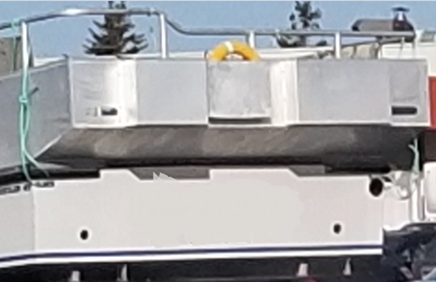RDIMS No .: 19470291
Date (Y-M-D) : 2024-01-15
Scope
This bulletin applies to Authorized Representatives (AR) and Masters of Canadian fishing vessels subject to the Fishing Vessel Safety Regulations.
Purpose
This bulletin covers important safety information and regulatory requirements when adding a removable deck to a small fishing vessel.
What you need to know
A removable deck (also called “false deck”) is a temporary deck structure added to a vessel that creates a cargo area below it and the vessel’s principal afterdeck.
The removable deck and the extra gear (like pots, nets, and equipment) stored on it raise the vessel’s vertical center of gravity and increase its lightship displacement. Both factors can negatively affect a vessel’s stability. The enclosed space below the removable deck will also increase the vessel’s gross tonnage.
The photos above show examples of removable decks fitted above the vessel’s gunwale (washboard).
The higher the weight and the location of the added deck, the greater the negative impact to the vessel’s stability. As such, a removable deck’s weight and height should be as low as possible.
The Transportation Safety Board has connected modifications that affected a vessel’s stability to several fishing vessel incidents. They outlined their concerns in their 2022 Watchlist:
“From 2010 to 2021, the [Transportation Safety Board] conducted 37 commercial fishing–related investigations where recurring unsafe conditions were identified. During this same period, 128 fatalities resulted from 87 fishing accidents (Figure 1). The two most common reasons for fatalities were falling overboard and problems with vessel stability. The number of fatalities related to stability issues has increased due to a few occurrences involving multiple fatalities.”
If you do not account for changes to a vessel’s original design, stability or gross tonnage, it can put the vessel and crew in danger. It also means that your vessel does not comply with Canadian law, so it could be detained, or you could be fined.
Requirements for Masters and Authorized Representatives
Canadian law requires that a fishing vessel’s Authorized Representative (AR) and Master make sure their vessel meets all Canadian rules (regulations). When a vessel is modified from its original design, the Authorized Representative must make sure that it is designed, built, and equipped to be seaworthy and operate safely.
When a fishing vessel is modified from its original design with the addition of a removable deck, it must continue to be designed, built, and equipped to operate safely and be seaworthy in its area of operation. You need to address all these factors:
Stability
According to Canada’s regulations, adding a removable deck is a major modification. As such, the vessel’s stability needs to be reassessed so the Authorized Representative, Master, and crew can safely operate the vessel.
Adding a deck to a vessel that has already been assessed for stability
You must update the vessel’s stability assessment to account for the removable deck, additional catch capacity and raised equipment (pots, nets, etc.).
If adding the deck does not negatively affect the vessel’s stability, the competent person conducting the analysis should add this determination to the vessel’s original stability booklet or record of stability.
Adding a deck to a vessel that has not been assessed for stability
If you want to add a removable deck and your vessel’s hull length is 9m or more, it will need to be assessed for stability.
If you want to add a removable deck and your vessel’s hull length is less than 9m, you must be able to show that the modified vessel has adequate stability to operate safely. This means that the vessel’s stability may need to be assessed.
Drainage
Installing a removable deck can impact freeing ports and drainage arrangements. New requirements can result from enclosing the space or increasing the vessel’s gross tonnage (see below). Please consider how a removable deck could affect your vessel’s drainage before installing a removable deck.
Tonnage
If the installation of a removable deck has an impact on the vessel’s characteristics indicated in the registry, including the tonnage, the vessel needs to be remeasured to confirm the information on the vessel’s Certificate of Registry are still accurate. Any modification of gross tonnage must be reported to the Vessel Registration Office.
A vessel that changes gross tonnage from not more than 15 (15 and below) to above 15 will need to comply with Part 1 instead of Part 2 of the Fishing Vessel Safety Regulations and will be subject to mandatory inspection and certification as per the Vessel Safety Certificates Regulations.
This will require the vessel to undergo all inspections required by TP 15456 – Canadian Vessel Plan Approval and Inspection Standard, including the submission of all plans required by this standard.
More information
- TP 15392 – Guidelines for Fishing Vessel Major Modification or a Change in Activity
- TP 15393 – Adequate Stability and Safety Guidelines for Fishing Vessels
- Small fishing vessel safety web pages
- How to enroll in the Small Vessel Compliance Program Fishing (SVCP-F)
- SVCP guidance for small fishing vessels - TP 15356E
Keywords:
1. Removable decks
2. Stability
3. Fishing Vessel Safety Regulations
Questions concerning this Bulletin should be addressed to:
AMSDS
Transport Canada
Marine Safety and Security
Tower C, Place de Ville
330 Sparks Street, 11th Floor
Ottawa, Ontario K1A 0N8
Contact us at: Email: marinesafety-securitemaritime@tc.gc.ca or Telephone: 1-855-859-3123 (Toll Free).


